Under the light of a single lamp, P’Yuth lays out three bags of beans on the slab of unfinished wood that serves as his dinner table. “Wet. Dry. And honey process,” he says, pointing to each sack of coffee.
The night is dense and it’s almost sweater weather. We’ve finished the home-cooked dinner of his fried fish, omelette, shrimp sauce and curry, and the plates are stacked to the side.
His coffee beans vary in color and size, but all come from the surrounding mountains of northern Thailand, grown on small farms run by families who own their own land. Fifty years ago, much of their land may have been covered in the opium plantations of the Golden Triangle.
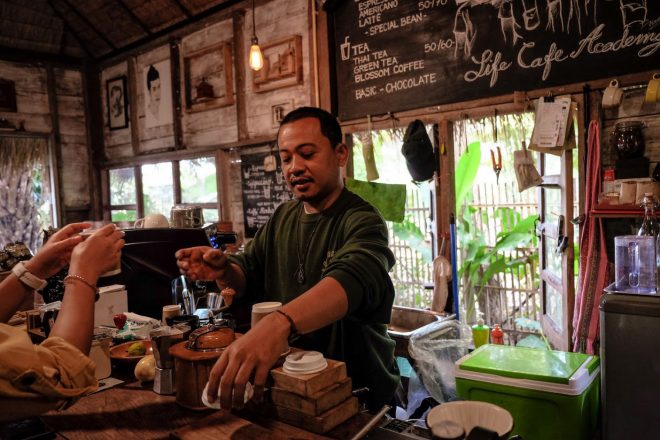
Now, the farmers work with P’Yuth to pick only the ripest of the coffee “cherries.” He then processes them himself in the town of Chiang Dao. Wet, dry and honey process are methods for removing the fruit and sugar mucilage of the coffee cherry, a crucial step to prepare the coffee for roasting.
P’Yuth isn’t from Chiang Dao. He’s from the south of Thailand; he worked a corporate job and had a popular cafe in Bangkok before dropping it all and moving to Chiang Dao to learn coffee. Like many, he took to this small town an hour north of Chiang Mai for the mountains, the place’s slower energy, and the people’s creativity.
We’re here for the same reasons as P’Yuth.
Chiang Dao is a calm delight – waterfalls, hot springs, bungalows plunked on the eaves of the mountains, a breadth of food options, artists workshops, and a manageably-sized cave. And it’s almost comically easy to get to from Chiang Mai.
Where to stay in Chiang Dao
$$$ Bungalows
Farm63 Chiang Dao
Wooden cabins by the riverfront in a peaceful surrounding
$$ Resort
Chiang Dao Hut Resort
Resort where most bungalows face the mountain rock faces and jungles
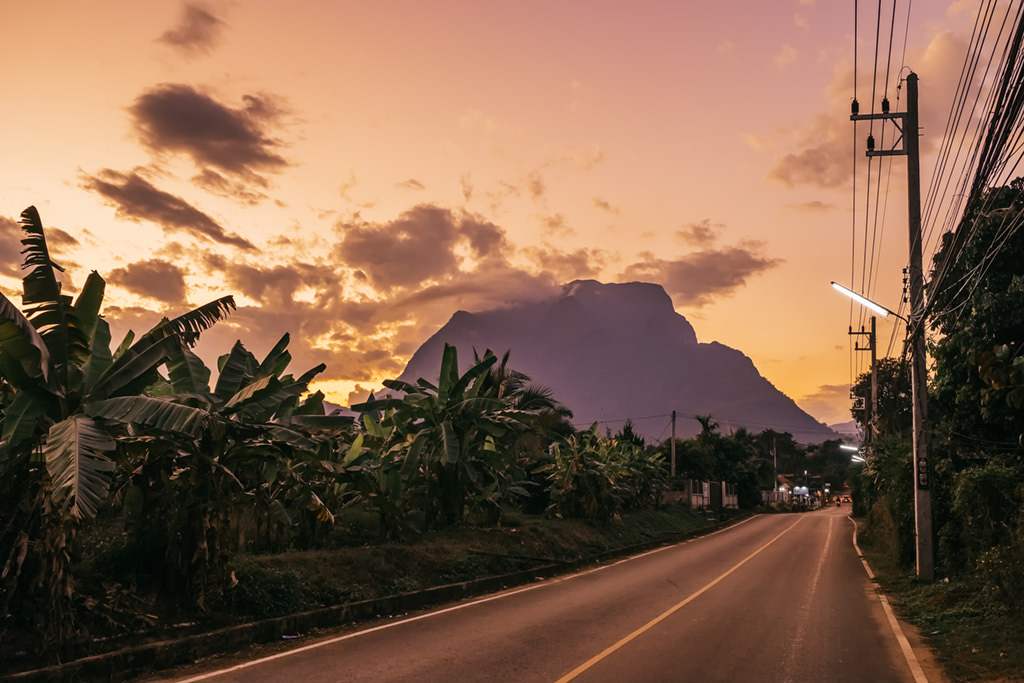
Though it’s clearly a tourist destination, the only place here with crowds is the parking lot of the Chiang Dao Cave, often swarmed by silver minibuses.
At night, the main road in town is only street lights, shuttered shops and a couple of 7-11s. The road with the tourist bungalows is slightly more lit up, and a couple of low-key bars are scattered around the area.
Chiang Dao isn’t the “most” or “best” of anything. The steep mass of jungle that cradles the town is the third tallest mountain in Thailand, Doi Luang Chiang Dao, with its thick green slopes and serene rock faces. But after four trips to the area, I’ve never climbed it. I’ve never tried.
It’s a testament to the draw of everything else in Chiang Dao.
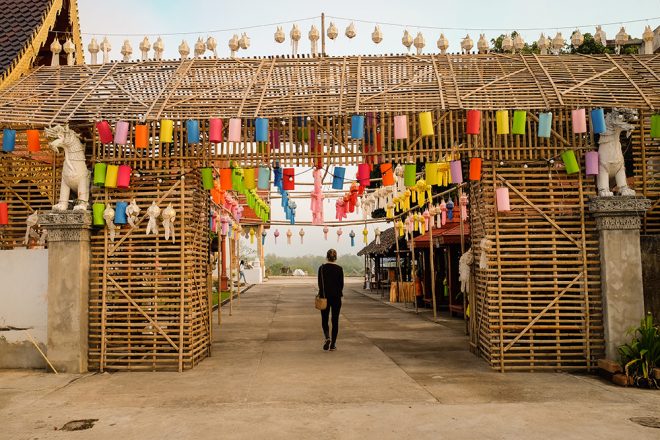
The next day, P’Yuth shows us a worn clay pot, no bigger than a gallon, on the end of a metal rod that’s attached to a Tuk Tuk-size engine. He switches the machine on and two short pipes spread rows of flame across the bottom of the pot as it begins to rotate.
“This is the traditional method for coffee roasting. The pot is from the same artist who makes my cups – she lives here in Chiang Dao.”
Like in any small community, this collaborative, supportive spirit is what makes Chiang Dao work. Each person’s project depends on the energy that others are putting into the community.
We’re only visitors, and we don’t have anything to offer except some rice wine from a friend’s village in Prae. It’s not much, but P’Yuth is appreciative. He shares his knowledge with students who come to study coffee, but prefers to keep his business small – if you’d like to find him and learn about coffee, just ask around in town.
What to do in Chiang Dao
Some of the better-known things to do (and the better places to stay) in Chiang Dao are located on the Ban Tham road, a ten-minute drive northwest of town, rather than on the main road (Highway 107).
It’s easy enough to get a songthaew (100 THB each way) or hitchhike from the bus station, or anywhere in town, out to Ban Tham. There are also motorbikes for rent in town for 300 THB per day (guesthouses can also arrange a rental for you, similar rate).
Chiang Dao Cave
Northern Thailand and caves are now synonymous with the story of the Wild Boars – the 12 boys and their soccer coach who were trapped in a cave in Chiang Rai for two weeks before being miraculously rescued (if you don’t know the story, start here).
But don’t let this turn you off of Thailand’s many perfectly safe caves!
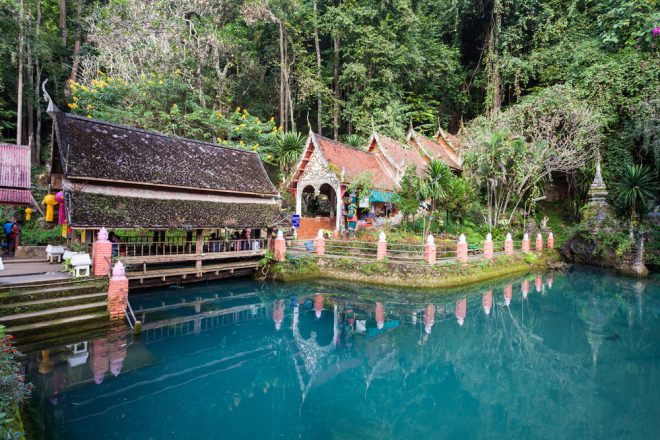
Chiang Dao Cave might be the area’s best-known attraction, and it’s worth a stop to see the caverns and Buddhist shrines within.
There are two portions to the cave: the main, lighted portion, which takes about 30 minutes to an hour to see, and the deeper, pitch-black portion that you need a guide to see.
The dark portion is an adventurous exercise in trusting your guide and feels just a bit Indiana Jones, but it’s a regular stop on the tourist trail in Chiang Dao so it seems relatively low-risk.
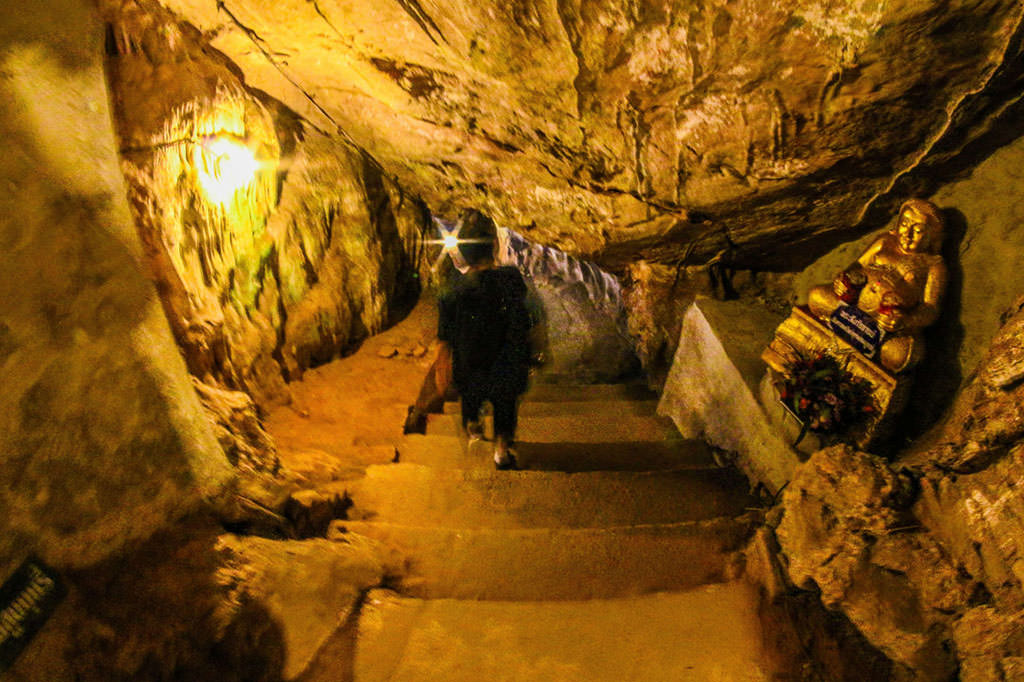
Entrance to the cave costs 100 THB. If you want to hire a guide and explore the dark portion inside, it’s 100 more. Some of the guides speak English, but not all.
It’s also possible to visit the cave as part of a tour departing from Chiang Mai.
Wat Tham Pha Plong Chiang Dao
Two kilometers up the road past Chiang Dao Cave is Wat Tham Pha Plong Chiang Dao, the “walking temple” of Chiang Dao.
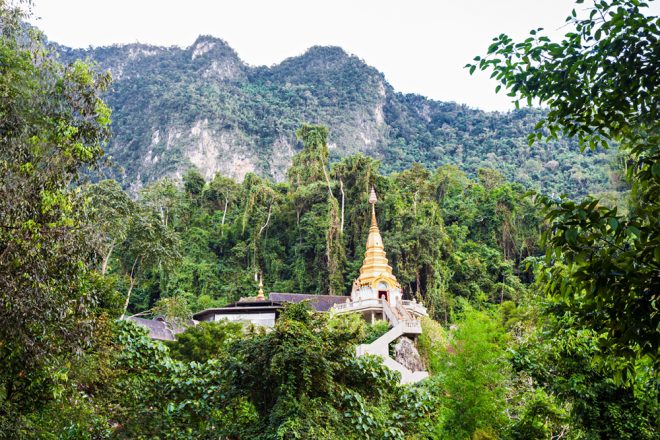
The road ends in the temple’s parking lot and up above you, 500 steps wind their way up to a golden pagoda. The walk up takes you along the edge of the jungle, with introspective and spiritual quotes posted along the way.
Just before the pagoda at the top, the main hall of the temple is set into the side of the mountain in a small cave, and once you reach the top, it’s a great vantage point to see some of the jungle.
There’s no entrance fee for the temple. Though it’s a long walk up and it might be hot, be sure to dress in appropriate temple garb (cover your knees and shoulders). The temple has umbrellas for you to borrow for the walk if needed.
Doi Chiang Dao
If you’re thinking Wat Tham Pha Plong sounds like too much walking uphill, you can always climb Doi Chiang Dao.
I’ve never hiked the 2,175 meter-high peak, but here’s what I’ve been told: the hike takes you through a remote wildlife preserve. It’s 8 hours roundtrip – 7.5 kilometers one-way with elevation gain of about 1100 meters (you start higher than sea level, if that’s not clear).
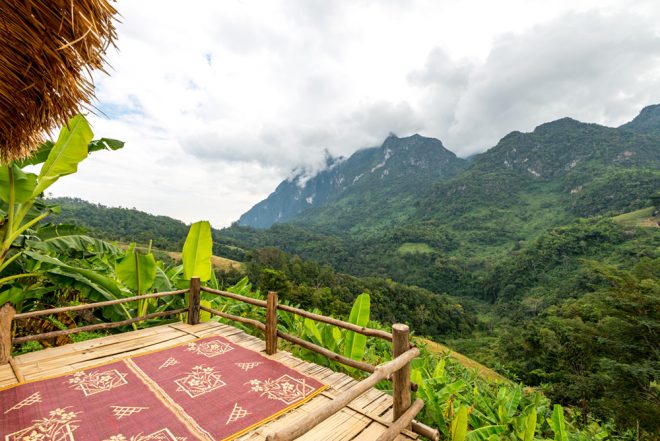
The trail starts a short drive inside the park. Some folks do it in a day, but part of the appeal is to see the sunrise from the top so overnight treks are popular. It costs 200 THB to enter the national park, and guides start at 1000 THB for a group. Organize a trek through a guesthouse, or set it up yourself with the national park office.
Chiang Dao Hot Springs
At the end of a bumpy road to the south of the Ban Tham area are the Chiang Dao Hot Springs. Concrete tubs just big enough for two or three people are set against a stream, with the near-boiling mineral water piped in from across the street. This might be the most relaxed I’ve been while still basically being in the jungle.
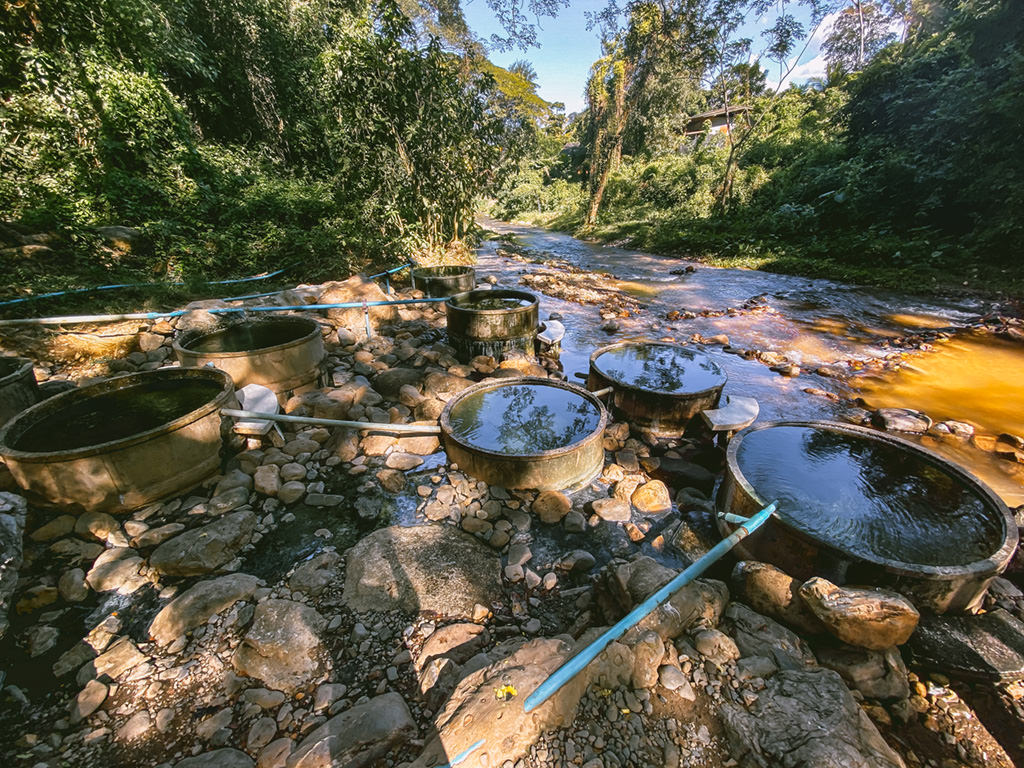
Thai tourists and locals from Chiang Dao love the place, so visit at night or early morning to avoid the crowds, or embrace the Thai family vacation experience (or pay 50 THB to use the private hot spring next door, it looks to be pretty similar).
This would be a great, easy ride if you decide to rent bicycles for a day and ride around (available for 100 baht in town or through some guesthouses).
Makhampom Art Space
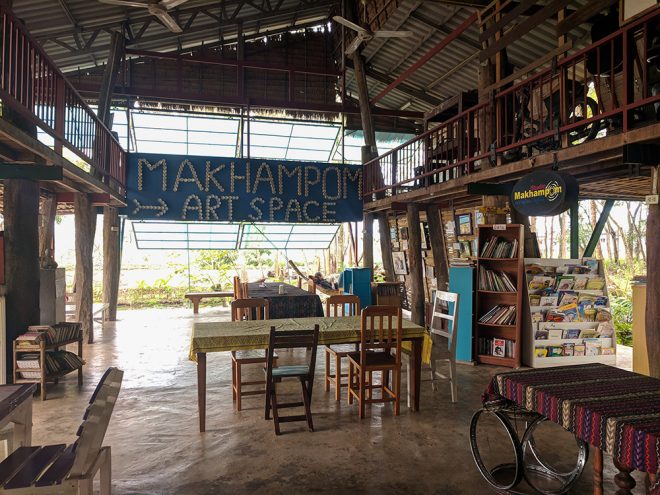
If you do a day on bicycles (or a moto), another great stop is the Makhampom Art Space, one of the funkiest spots in already-artsy northern Thailand. A plot of land run by an artists’ collective, Makhampom is home to the a theater group (ask about workshops and performances), a cafe and the studios of local sculpture and mixed media artists.
They’ve turned the place into their own collaborative art exhibition, with the scarecrows in the little rice paddy out front and a set of instruments made from recycling. Entrance is free; it’s a two kilometer walk from the bus station, east of town.
Where to eat and drink
Chiang Dao Nest
Chiang Dao Nest serves the best Western food in town and has earned their keep for over 15 years. They do brunch, italian, sandwiches, roasts, toasts and a full page of salads – baked egg dishes with swiss cheese and salmon, pasta with fire-roasted tomatoes and fresh parmesan, brie toast.
It’s a little pricey (150-200 THB for most plates), but the decadence of the food is worth it and the green surroundings are designed to make the most of their amazing setting underneath the mountain. Their menu is posted here. Their sister restaurant, Nest 2, serves similarly well-regarded Thai food, but I’ve never managed to stop in.
Sudjairai
Sudjairai is all vintage Thai cowboy ambiance, with live music, drinks and plenty of local Chiang Dao-ers to meet. At the corner of the Ban Tham road and one of the highways, they serve great standard Thai fare – curries, larb (chopped meat and pork salad), pad thai and pad see ew, tom yam, yam kai dao (fried eggs spicy salad) and som tam (papaya salad).
Microkosmos Craft Beer
IPAs, stouts, ambers and goses have arrived in Chiang Dao. The secret’s already out, but since Chiang Dao has stayed small, there’s no crowd.
Microkosmos is a home-brewing operation that serves craft beer (and national lagers) from Thailand and around the world. Thailand still taxes imported alcohol exorbitantly, so the nice beers start at 180 THB. The kitchen also serves spot-on burgers and fries.
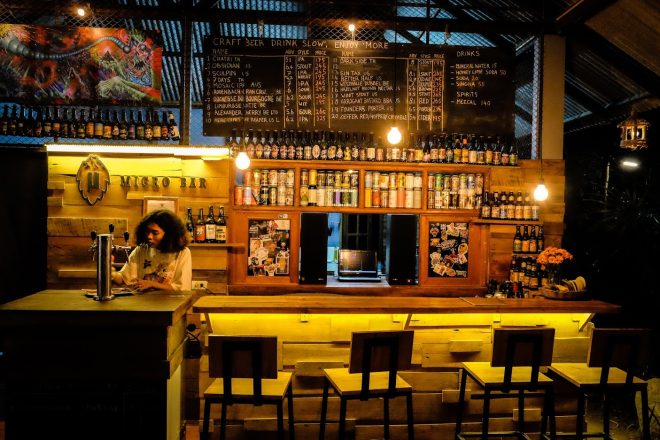
Quick note for the vegans and vegetarians: though most places will make you something that works, there’s a classic Thai vegan (jay) place on the main road in the north half of town, here (breakfast and lunch only).
Where to stay in Chiang Dao
Chiang Dao Hut Resort
Chiang Dao Hut Resort is a simple, 400 THB (sometimes less) per night bungalow spot on the Ban Tham road. The highlight is the setting – most of the porches face the rock faces and jungles that hang off the side of the mountain.
Malee’s Nature Lovers Bungalows
Malee’s Bungalows is down the quiet road to the Nest and Wat Tham Pha Plong and they have a pool, a lush garden and a great little restaurant. Breakfast sports fresh-baked bread and local jams. It cost just a little more than Chiang Dao Hut (or a lot more, in high season).
Chiang Dao Nest
The Nest is also one of the nicer spots in Chiang Dao to take a bungalow. They have a swimming pool, the huts are clean and have AC, and it doesn’t get better than this for an on-site restaurant in Chiang Dao. Bungalows start at 950 THB, and they only take reservations through their website.
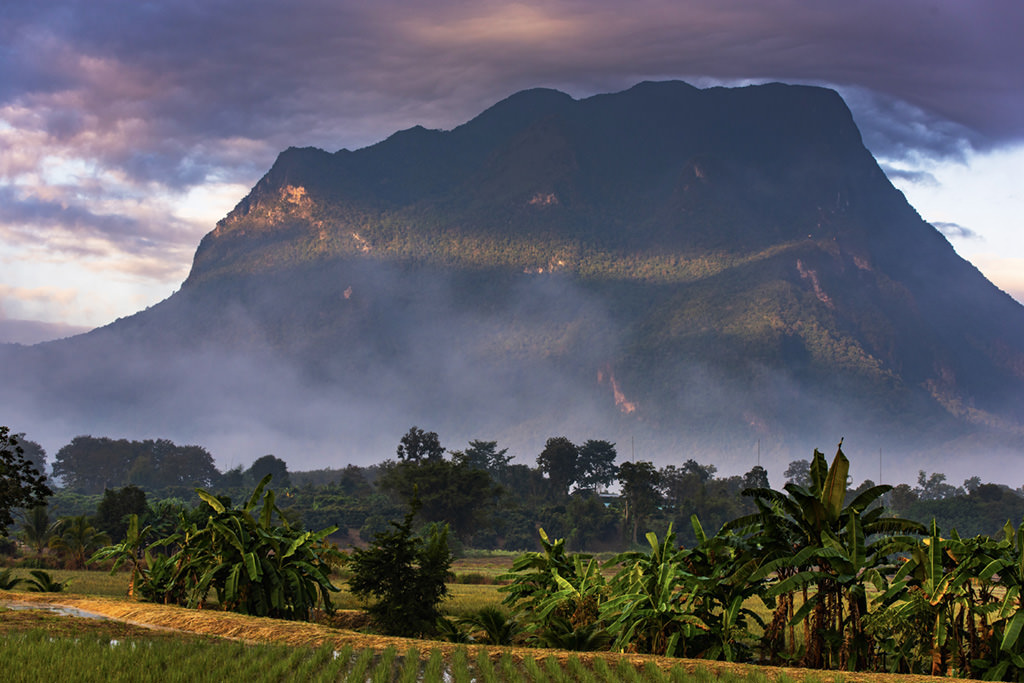
How to get to Chiang Dao
If you can ride a motorbike (safely), this is the best way to do Chiang Dao. You’ll want on while you’re there anyway, and the drive up is easy and takes you through one of the greenest, lushest river canyons I’ve driven through in Thailand. Take Highway 107 (the Mae Rim Road) north out of Chiang Mai and go straight gor an hour or so. Stay left at the intersection to the south of town if you’re headed to Ban Tham and the cave road.
If you’d rather go by bus, head to Chang Puek bus station, just north of the old city (not the main bus station). They leave every 30 minutes and cost 40 baht. It’ll drop you at the bus station in the middle of Chiang Dao town though, and you’ll have to hitch or songtaew (100 THB) up to most guesthouses.
Some links may be affiliate links, meaning I may earn commission from products or services I recommend. For more, see site policies.
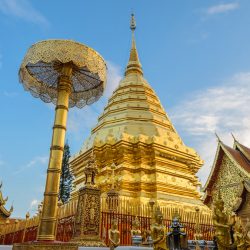
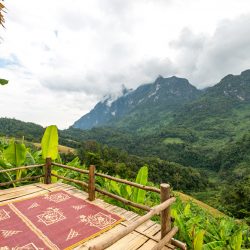




its really amazing post and very helpful for travelers how want to explore this
Wow, I knew about Chiang Dao in Chiang Mai province in northern Thailand. I had visited Thailand twice, one as a tour coordinator and other as a girls gang trip. During second trip I had wonderful experience with full moon party at Koh Phangan. I have plan to visit this wonderful travel circuit when I will be there on my next Thailand trip. Lets hope this pandemic to get over and travel industry to get its full boom. ThanX
Hi Marek
Where is the locationof the cafe of P’Yuth?
I can’t find it.
Thank you
Hi Pichan – I think you’ll find it here
The link seems to be broken. Please could you post another? Really nice archival thank you- we’re heading to chiang dao based on your recommendation 🙂
It appears they deleted their FB page. It’s Hoklhong Cafe 🙂 https://www.instagram.com/hoklhong/?hl=en Enjoy Chiang Dao!
Nice piece Marek. Will visit next trip.
Beautiful post. Love to see articles covering places that are not as well known as many of the tourist magnet cities! Definitely want to check out Chiang Dao next time I’m in Thailand!
Glad you appreciate it Sara! This article is part of a conscious effort to cover less-known places 🙂